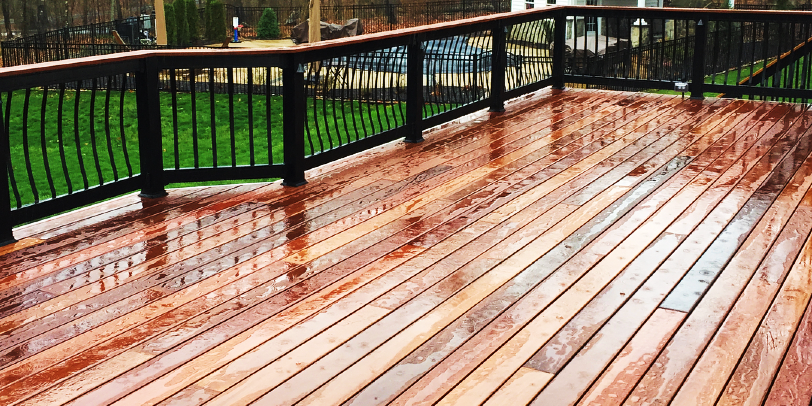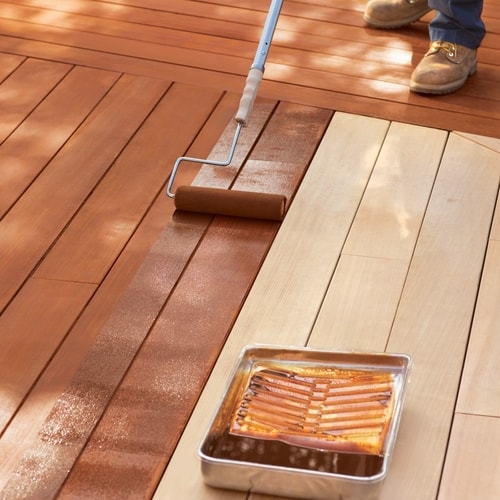A Comprehensive Guide to Different Kinds Of Deck Staining Techniques for Ultimate Protection and Appearances
In the world of deck upkeep, the art of tarnishing stands as a crucial action in the direction of both protecting the integrity of your exterior room and boosting its aesthetic charm. As we navigate through the elaborate world of deck staining strategies, one starts to appreciate the nuanced methods that can make all the difference between a sub-par coating and a perfect one. From the choice of the suitable stain kind to the careful application techniques, each aspect plays an important role in achieving that excellent equilibrium between defense and appearances. Join us as we reveal the tricks behind achieving the ultimate deck discoloration results-- a trip where every brushstroke shapes not simply the surface, but the really essence of your outdoor refuge.
Comprehending Various Sorts Of Discolorations
Various kinds of stains are frequently used in the procedure of deck staining to accomplish various aesthetic and safety results. Transparent discolorations are perfect for showcasing the all-natural grain of the wood while offering marginal protection against UV rays and dampness. On the other hand, semi-transparent spots supply a balance between shade enhancement and security, permitting some wood grain to show with. For an extra opaque surface that supplies optimum protection against the aspects, strong stains are the favored option. These discolorations come in a variety of colors and properly hide the wood grain.
In addition, there are additionally specialized discolorations such as sealants and printer toners. Toners include a tip of shade to the timber while supplying marginal defense, making them ideal for more recent decks with much less wear. Sealants, on the various other hand, offer security against moisture and UV rays without adding shade, making them a preferred selection for decks that currently flaunt a preferable shade. Comprehending the qualities and benefits of each type of stain is essential for achieving the desired appearance and durability for your deck.
Selecting the Right Stain Shade
When taking into consideration the aesthetics of your deck discoloration job, the choice of tarnish color plays an important role in boosting the protective top qualities of the picked stain kind (Right Deck Stain). The color you pick can substantially impact the total look of your deck, along with its capability to withstand the components in time
When picking a discolor shade, it's important to consider the existing color pattern of your home's outside. Harmonizing the deck discolor with the general visual of your property can develop a natural and aesthetically attractive outdoor room. Furthermore, the shade of your deck discolor can affect the temperature of the deck surface; darker shades tend to absorb even more warmth, while lighter colors show sunshine and stay cooler.
In addition, the kind of wood you are tarnishing will also impact just how the stain color shows up. Various timber species can engage with the tarnish in various ways, potentially modifying the last shade. It's recommended to check the tarnish on a tiny, inconspicuous area of the deck to make sure the shade ends up as wanted before waging the entire job.
Preparing Your Deck for Discoloration
To make certain a lasting and successful deck discoloration job, thorough preparation of the deck surface is important. Begin by cleaning up the deck completely to eliminate dust, gunk, mold, and any type of old discolor or complete. Utilize a deck cleaner or a blend of water and cleaning review agent in addition to a tight brush or stress washing machine to scrub the surface clean. After cleansing, permit the deck to completely dry entirely before proceeding to the following action.
Examine the deck for any damaged or rotten boards that require to be changed. Hammer down any type of sticking out nails and sand any kind of harsh locations to guarantee a smooth surface for discoloration. Look for any type of loose barriers or steps that might require tightening or fixing.
Once the deck is tidy, dry, and in excellent repair work, take into consideration applying a timber brightener to restore the deck's all-natural color and open up the timber pores for better tarnish penetration. Lastly, protect any type of neighboring plants, furniture, or surface areas with plastic sheeting before continuing with the staining process. Correct prep work is essential to attaining a professional-looking finish and optimizing the long life of your deck stain.
Applying Spot With Different Strategies
For a flawless and expert coating, the method of applying discolor plays a crucial role in improving the appearance and durability of your deck. There are several methods you can use to make sure a reliable application of stain.
It is excellent for detailed locations and getting to between deck boards. Back-brushing after rolling is recommended to even out the tarnish and function it into the wood for better infiltration.
Splashing is one more popular method, offering rate and ease of application, specifically for big deck locations. Whichever technique you pick, guaranteeing correct preparation and adhering to producer standards will aid achieve a attractive and lasting tarnish finish on your deck.

Keeping and Re-staining Your Deck
When it comes to re-staining your deck, the frequency depends on different factors such as the type of tarnish utilized, the environment in your area, and exactly how much wear and tear your deck experiences. Generally, it is recommended to re-stain your deck every 2-4 years to maintain its defense and visual appeals.
Prior to re-staining, ensure the deck is tidy, completely dry, and without any kind of previous stain residue. Fining sand might be required to ravel harsh areas or eliminate old tarnish that is flaking. Choose a top notch stain that fits your deck's product and gives the preferred degree of defense. Apply the tarnish evenly utilizing the proper technique talked about previously in this guide to make sure a gorgeous and resilient finish - Water-Based Stains. By remaining proactive with maintenance and re-staining, you can delight in a well-protected and aesthetically enticing deck for several years to come.
Verdict
Finally, recognizing the various kinds of deck discolorations, selecting the ideal color, correctly preparing the deck, applying stain with various techniques, and keeping and re-staining the deck are important steps for ultimate defense and appearances. By adhering to these actions, you can make sure my explanation that your deck stays in top problem for many years to find.
Additionally, the shade of your content deck tarnish can influence the temperature of the deck surface area; darker colors tend to soak up more heat, while lighter shades show sunlight and remain cooler.
It's recommended to test the tarnish on a little, inconspicuous location of the deck to guarantee the shade transforms out as desired prior to proceeding with the whole job.

Comments on “Water-Based Stains for Your Deck: Benefits and Applications”